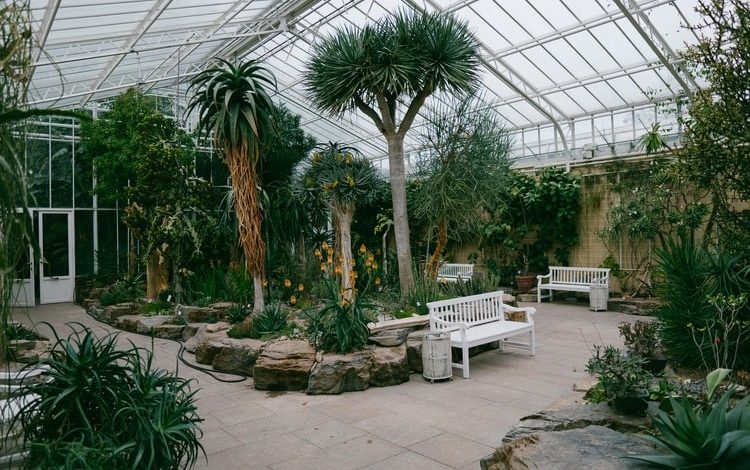What Is a Botanical Garden?

Botanical gardens are gardens cultivated for scientific research, conservation of biodiversity, and exhibition. They’re otherwise known as botanic gardens. They exist primarily for research, educational, and aesthetic purposes.
Universities and research institutes are usually in charge of running botanic gardens. These institutions collect and cultivate specialized plant species from across the globe. Some of these specialized plants are tropical plants, alpine plants, and succulent plants. Queen of the night cactus, mimosa pudica, and parachute flower are some plant species under these categories. These institutes file these plants according to family and genera.
Some botanical gardens also serve recreational purposes. As such, museums, libraries, and musical and theatrical displays are part of their facilities. There are also specialized areas in a botanic garden. One of such is an arboretum. An arboretum is a part of a botanical garden, specifically for trees and woody plants. Fruticeta and herbaria are some other specialized areas.
The plants cultivated in a botanic garden depend on the institute running it. The institute decides what to specialize in based on available resources. It also takes into consideration the location of the garden. However, regardless of the plants collected and cultivated, the aim remains research and aesthetics.
There are about 1,800 botanical gardens across 150 nations today. An estimated 300 million visitors visit these gardens every year. Of these 1,800 gardens, 500 are in Europe, and 200 are in North America. Specific organizations, like the International Association of Botanical Gardens (IABG), coordinate the affairs of these gardens. The IABG is an affiliation of the International Union of Biological Sciences. Another organization tasked with coordination is Botanical Gardens Conservation International (BGCI). The BGCI has over 700 members in about 118 countries.
History of Botanical Gardens
The origin of modern-day botanic gardens is from psychic gardens in China and Greece. These gardens grew herbs, which got used for medicine. Later on, Aristotle planted a botanic garden in Europe where people studied botany.
However, modern-day botanists do not consider this garden botanical. The reason for this is the unsystematic arrangement of the plants. Modern gardens organized their plants according to Carl Linnaeus’s system of classification. However, that system of classification didn’t exist in Aristotle’s day.
Regardless, the psychic gardens continued and eventually evolved. By the 16th and 17th centuries, there were more botanical gardens globally, especially in Europe. In Italy, the first botanical gardens were established in 1543 at Orto Botanico di Pisa and in 1544 at Orto Botanico di Firenze and Orto Botanico di Padova.
The gardens in Europe were majorly in universities and medical schools. Thus, they were mainly scientific. By the eighteenth century, Swiss botanist Jean Gesner noted that there were about 1600 botanical gardens in Europe alone. The reputable botanists of that era directed most of these gardens. In these gardens, botanists developed the nomenclature system for plants.
John Bartram, a botanist, established the first botanical garden in America. He built it in Philadelphia in 1728. Bartram’s garden featured both native and exotic plant species. The garden, however, became inoperative during the American revolution.
Over time, botanical gardens continued to evolve. From being purely scientific, they also became centers for recreation and aesthetic value. Conservation and environmental sustainability also became part of their objectives.
What Is an Arboretum?
An arboretum (plural: arboreta) is a part of a botanic garden meant for trees and woody plants. It could also be a specialized botanical garden of its own. John Claudius Loudon first used the term in 1883 in The Gardeners Magazine. However, the concept dates as far as the ancient Egyptian pharaohs.
Arboreta also have several specialized branches. There are arboreta for conifers, willows, oaks, and shrubs. The Arnold Arboretum of Harvard University and the United States National Arboretum are two of the most popular arboreta in the U.S.

What Is an Herbarium?
An herbarium (plural: herbaria) is a collection of plant specimens mounted on a sheet of archival paper. Botanical gardens usually have these collections. They use them majorly for study and research. However, they also serve as a means of conserving biodiversity.
The archival paper displays the complete morphology of the plants. It carries their common and scientific names and natural habitat, as well.
Herbaria also have different specialized branches. There are herbaria for woody plant species and horticultural plants.
Functions of Botanical Gardens
Botanical gardens perform several roles that underline their importance in today’s world. They’re sites for scientific and educational research. They also serve purposes in plant conservation, aesthetics, and recreational activities. We’ll outline and briefly explain some functions of botanical gardens below.
Ex-Situ Conservation
Ex-situ conservation is simply the conservation or preservation of biodiversity outside its natural habitat. As a result of human activity on earth, lots of plant species have gone extinct. Some are thinning out and are on the verge of extinction. Therefore, the conservation of plant biodiversity is essential, and botanical gardens are sites for plant species conservation and preservation.
Botanical gardens across the globe are home to rare plant species collected mainly for preservation. Collections of herbaria in these gardens also help in maintaining plant biodiversity. As such, botanical gardens play a massive role in saving plant species from extinction.

In-Situ Conservation
In-situ conservation is the preservation or protection of biodiversity within its natural habitat. Botanical gardens serve as sites for preserving plant species within their natural home. People cultivate arboreta in the natural home of some trees as a means of conserving them. Besides preserving biodiversity, in-situ conservation also ensures environmental sustainability.
Scientific Research and Educational Purposes
The first botanical gardens served purely scientific purposes. The evolution of botanical gardens over time hasn’t changed this. Today, botanical gardens are still mainly used for scientific research and study. Taxonomy, plant anatomy, physiology, and conservation biology are some fields where scientists research botanical gardens.
Also, these gardens are home to unknown plant species. Here, scientists study, identify, and name them. They serve as venues for scientific workshops and educational seminars as well.
Aesthetic and Recreational Value
Botanical gardens also offer aesthetic and recreational value to lovers of nature. They provide an opportunity to enjoy life and the grandeur of its beauty. Some botanical gardens also add musical and theatrical displays and art exhibitions to their facilities. These facilities serve as a means of recreation and relaxation to visitors.
Botanical Gardens in the United States
There are botanical gardens in almost every state in the United States. There are approximately 600,000 living plants collected and cultivated in these gardens. Also, there are about 40,000 species within these collections. Below are some of the botanical gardens across the United States of America:
New York Botanical Garden
The New York Botanical Garden is one of the most extensive botanic gardens in America. The garden spans over 250 acres. It also has around 50 specialty gardens and over one million plant species. The world’s most extensive collection of indoor palm trees is also among these numerous plant species. This wide variety of plant life makes the New York Botanical Garden a living museum.
Like most botanical gardens, this garden serves as a research institute. Around 65,000 students visit the New York Botanical Garden for research yearly. Also, the garden is a significant site for plant conservation and preservation.
Missouri Botanical Garden
Henry Shaw established the Missouri Botanical Garden in 1840. As such, it’s among the oldest botanic gardens in the United States. The garden spans over 75 acres and has over 6,000 species of plants in the display. It’s also home to one of the most extensive Japanese-style gardens in the U.S. This specialist garden, alongside its other attractions, makes it one of the most beautiful places to visit in America.
United States Botanical Garden
The United States Botanical Garden has been in operation since 1850. It’s among the oldest botanic gardens in the U.S. The garden is relatively small but features some beautiful scenery and attractions. It has about 65,000 plants on display, with over one million visitors coming to take in its sites yearly.
Desert Botanical Garden
The Desert Botanical Garden is a unique garden established by the Arizona Native Plant Society. The society built it in 1939. The garden strays from the lush green theme of conservational gardens and wears a more desert-themed style. As such, it displays the diverse plant life of the Sonoran Desert. It has over 50,000 plants on display, all shown in enchanting desert scenery.
San Francisco Botanical Garden
The San Francisco Botanical Garden is a fifty five-acre living museum with a wide variety of plant species. Over 8,000 plants have found a home in this garden. These plants are both native and exotic species collected from across the world. It also features the fourth most valuable magnolia collection on the planet. This collection makes the garden an essential conservation site in America and the world.
Dallas Arboretum and Botanical Garden
The Dallas Arboretum and Botanical Garden is a sixty six-acre living museum in Dallas, Texas. It features an impressive number of beautiful scenery and plant species. These brilliant attractions make it one of the most visited botanic gardens in the U.S. An estimated one million visitors visit this garden annually. These visitors come from over 90 countries across the globe. The garden also serves as a scientific research institute and conservation site. It’s also quite popular among tourists for other recreational activities.



